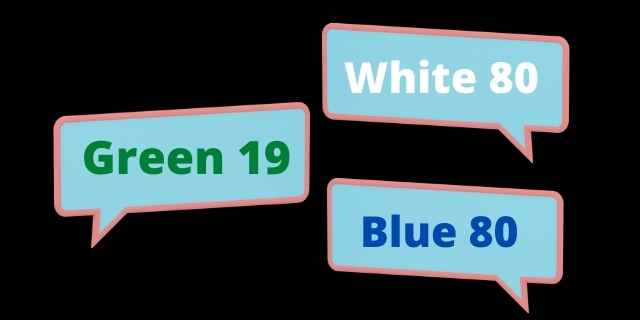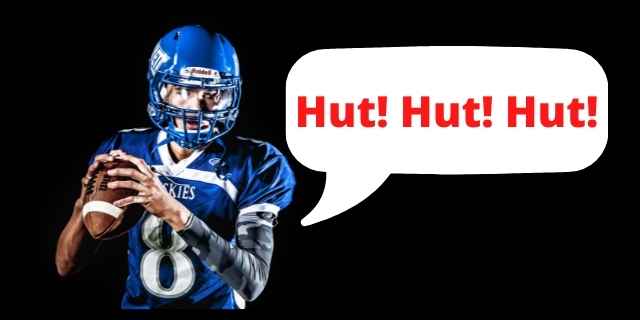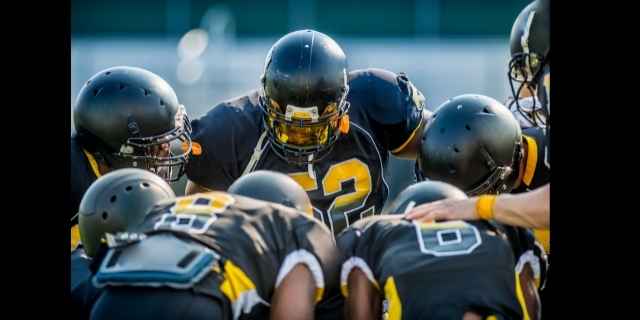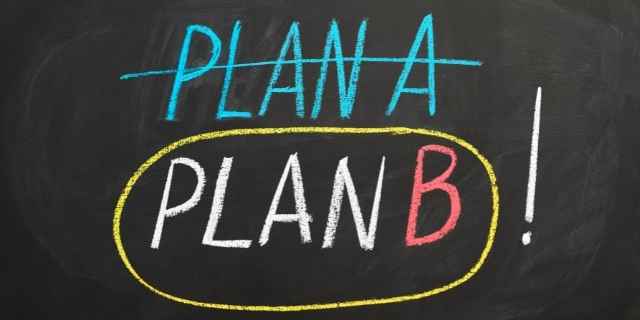In a football game, the teams line up to snap the ball to start every non-kicking play.
Before the ball is snapped, the quarterback can be heard yelling a series of colors, numbers and nonsense words. The prhase usually ends in one or more “Hut”s.
It could be something like: “White 80! Set! Hut!” What does this mean? These are different forms of pre-snap calls.
What Are Pre-Snap Calls?
Pre-snap calls are yelled before the ball is snapped back by the center to the quarterback. This is the quarterback communicating information and plays to his team.
The pre-snap call has several purposes. One is to tell the offense when the ball will be snapped and to signal the center to snap the ball.

The call can be used to change formation or to adjust blocking schemes. If a quarterback suddenly spots a weakness, he will use the pre-snap call to change the planned play.
In a no-huddle offense, it’s how the whole play is called!
Quarterbacks also use the pre-snap call to trick the defense into jumping offside.
What do the calls mean?
This is incredibly complicated. The meaning of calls can change from team to team, game to game, and even in-game.
Peyton Manning made the shout of “Omaha!” famous. When he was asked what it meant (while he was still playing), this is what he had to say.
“Omaha is a run play, but it could be a pass play or a play-action pass depending on a couple of things: the wind, which way we’re going, the quarter, and the jerseys that we’re wearing.“
Peyton Manning
Manning was joking, but only by a little! I’ll explain what Omaha really means in the section on changing plays.
If the offense thinks that the defense may have figured out their calls, the quarterback might do fake calls just to confuse them!
Mostly, this is done in code, but not always.
For instance, in recent games, it’s been common to hear Tampa Bay quarterback Tom Brady yelling to tight end Rob Gronkowski, “Gronk, slide in!”
This means Brady has seen something and wants to start from a tighter formation.
Call Cadence
“Cadence” usually means the rhythm of how people say a word or phrase. So what has this to do with snapping the ball?
Well, the offense has two huge advantages over their opposition. They know where the play is going, and they know when the ball is being snapped.
The cadence is how they maximize the advantage that knowing the snap count gives them.
Offensive players can concentrate on what they have to do in the coming play and watch defensive formation changes.
But defensive players have to have at least one eye on the ball at all times and not cross the line until it’s been snapped.
The part of the call that is made once all the adjustments have been called out is referred to as the cadence.
There are two parts to this:
- the warning that the snap is about to happen, and
- the order to snap the ball.
Why Do Quarterbacks Shout Colors And Numbers?

The warning part of the pre-snap call usually consists of a color and a number. Here are some examples that are often heard:
- “White 80”
- “Green 19”
- “Blue 80”
When the quarterback yells these out, it means that he is done adjusting and is about to call for the ball. He may call it out once, more than once, or drag it out.
Why Do Quarterbacks Say Hut?
“Hut!” is the signal to the center to snap the ball back to the quarterback. The phrase is at the end of the pre-snap call
The phrase is usually preceded by a “set” just to make sure everyone is still so they don’t get an illegal motion penalty.
How many huts?

The last thing a quarterback says before he leaves the huddle is that the play is on one, or two, or whatever number. This is the number of huts he will say before the ball is snapped.
If the quarterback says “on three” the cadence could be something like:
“White 80! White 80! Set! Hut! Hut! Hut!”
The ball would be snapped simultaneously with the third hut.
They may also snap on set, just to get a split second of surprise!
Why Do Quarterbacks Pick Up Their Leg?
When the crowd in the stadium is really noisy, the offense may have trouble hearing the pre-snap calls.
When the quarterback thinks this will be an issue, he has to resort to leg movements.
The quarterback will briefly lift his leg and put it down in a rhythm similar to the cadence of the call.
In this situation, the quarterback can no longer do an audible to change the play or adjust coverage. A loud stadium is a huge advantage for a defense!
Why do quarterbacks clap their hands?
Sometimes you’ll see a quarterback clapping his hands. No, he’s not impatient. It’s for the same reason as lifting a leg.
The hand clap will be heard by players when shouts are drowned out by stadium crowds. It’s the signal to the center to snap the ball.
Changing The Play

Some of the pre-cadence calls are made to change the play that the team is going to run.
When a team breaks the huddle, a play has been called for the offense to run. However, in most huddles, a backup play has also been called.
If the quarterback gets to the line and sees something that tells him that the main play may not work, he will yell something out that changes the play to the backup.
One common change call is:
“Kill, kill, kill”
Another is:
“Can, can”.
What did Omaha really mean?
After he retired Peyton Manning finally came clean about what Omaha meant.
He explained that it was a trigger word to tell the offense to change the play. He used it when there was low time on the lock, so the center needed to snap the ball quickly.
Manning was indicating to his offensive lineman that he was going to Plan B. He would draw out Omaha and follow it with “set, hut”.
O-ma-ha, set hut.

No Huddle Offenses
When an offense wants to push the defense and not give them time to substitute, they may run a no-huddle offense.
In the no-huddle, the offense runs up to the ball right after the umpire places it.
The first thing the quarterback calls out is the coded name of the play. For instance, he might yell “green 286”.
For this team, green may mean a passing play. 286 tells the receivers to run specific routes.
The code words change every week so that opposing teams don’t decode the play calls!
Using Pre-Snap Calls To Draw The Defense Offside
Often, quarterbacks play around with their cadence to trick the defense into a penalty by making them jump too soon.
They may throw in an extra “white 80” and yell it really loudly, or do an extra hard “hut” on one when the count is actually three, or any of several other tactics.
Green Bay’s Aaron Rogers is a master of this.
What Does “He’s The Mike!” Mean?
When the quarterback comes to the line, often the first thing you see is him pointing at an opposing player and yelling “He’s the Mike!”.
The Mike is the defense’s middle linebacker on any given play.
It is important to identify him because the offense’s entire blocking scheme is built around the position of the middle linebacker.
Since the offensive linemen start down in a stance, it’s sometimes hard for them to identify the Mike quickly.
What’s happening here is that the quarterback is telling the center who is the middle linebacker on that play. The center can then call out the blocking schemes from there.
In a really amusing clip on Youtube, the Cowboys quarterback can be heard calling out the Mike. Meanwhile, the Giant’s linebacker loudly denies that he’s the Mike!
A Typical Pre-Snap Call
It might go something like this:
He’s the Mike, 52’s the Mike, Blitz, Blitz, Red 27, Smith move in, Kill, Kill, Kill, White 80, Set, Hut!
Let’s decipher this sequence.
It could mean…
“That guy I’m pointing at is the middle linebacker so set your blocking up accordingly, that other guy I’m pointing at is about to blitz so someone needs to deal with him, now I’m saying some nonsense to confuse the defense, hey tight end, switch to a close formation, I’m changing the play to the backup play, I’m about to call for the ball, get set, and go!”
Whew! Did you catch all that? It really is a lot of information in a few words!